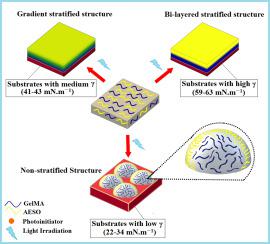Progress in Organic Coatings ( IF 6.6 ) Pub Date : 2022-07-28 , DOI: 10.1016/j.porgcoat.2022.107023 Sahar Abdollahi Baghban , Morteza Ebrahimi , Manoucher Khorasani , Shadab Bagheri-Khoulenjani

|
Self-stratification is an ecological method that leads to the stratified structures by one-layer application to reduce solvent emissions and energy consumption. Despite the great importance of the effect of surface properties on the self-stratification phenomena, the influence of the substrate type has not been examined in self-stratifying light-curing systems. This study aimed to design dissimilar self-stratifying patterns by using several substrates namely glass, steel, Al, polyethylene, polyethylene terephthalate, polyvinyl chloride, polypropylene, polystyrene, with different surface free energies (γ) (high γ: 59–63, medium: 41–43 and low: 31–34 mN.m−1) based on incompatible bio-renewable light-curable materials including methacrylated gelatin (GelMA) and acrylated epoxidized soybean oil diluted by the acrylated glycidyl neodecanoate (AESO-GN). To this, the impact of the essential substrate characteristics including γ and roughness on the self-stratifying behavior and other properties of the achieved coatings were studied by using SEM-EDX, contact angle (CA), FTIR-ATR, and the other conventional coating analyses. The results disclosed that the Funke theory had the potential to predict the self-stratifying behavior of the abovementioned light-curing coatings on a variety of substrates. Moreover, it was understood that self-stratification dealt with the γ of the substrate, so that the application and light-curing of coatings on the substrates with high and medium γ resulted in a bi-layered and a gradient concentration self-stratified structures, respectively. Furthermore, it was revealed that applying this coating on substrates with low γ led to an incoherent structure. Consequently, the know-how for tailoring several self-stratified coatings with different gloss values (54–88 at 60°), pendulum hardness (43–76), MEK double rub resistance (25–45)), glass transition temperature (44–72 °C), swelling degree (20–29 %), gel fraction (74–89 %), water CA (61–86°), and cross-cut adhesion (0B 4B) was realized. Besides, the findings demonstrated that increasing the surface roughness of steel substrate intensified the self-stratification. Accordingly, the coating-substrate interface is of great importance for self-stratification as its characteristics will identify the stratification pattern.
4B) was realized. Besides, the findings demonstrated that increasing the surface roughness of steel substrate intensified the self-stratification. Accordingly, the coating-substrate interface is of great importance for self-stratification as its characteristics will identify the stratification pattern.
In addition, it was observed that appropriate bi-layered coatings could not be attained by the consecutive application and curing of GelMA and AESO-GN layers. Consequently, this attempt provided beneficial insight into the design of green coatings via an ecological fast-curing methodology.
中文翻译:

在具有不同表面自由能的基材上的光固化涂层中定制各种自分层图案
自分层是一种生态方法,通过一层应用导致分层结构,以减少溶剂排放和能源消耗。尽管表面性质对自分层现象的影响非常重要,但在自分层光固化系统中尚未检查基材类型的影响。本研究旨在通过使用具有不同表面自由能 (γ)(高 γ:59-63,中: 41–43 和低: 31–34 mN.m -1) 基于不相容的生物可再生光固化材料,包括甲基丙烯酸化明胶 (GelMA) 和丙烯酸化新癸酸缩水甘油酯 (AESO-GN) 稀释的丙烯酸化环氧化大豆油。为此,通过使用 SEM-EDX、接触角 (CA)、FTIR-ATR 和其他常规涂层,研究了包括 γ 和粗糙度在内的基本基材特性对所获得涂层的自分层行为和其他性能的影响。分析。结果表明,Funke 理论具有预测上述光固化涂料在各种基材上的自分层行为的潜力。此外,据了解,自分层处理基板的 γ,因此,涂层在高和中γ的基材上的应用和光固化分别导致了双层和梯度浓度的自分层结构。此外,研究表明,将这种涂层应用在低 γ 的基材上会导致结构不相干。因此,定制几种具有不同光泽值(60° 时为 54-88)、摆锤硬度(43-76)、MEK 耐双擦性(25-45)、玻璃化转变温度(44 –72 °C)、溶胀度 (20–29 %)、凝胶分数 (74–89 %)、水 CA (61–86°) 和横切附着力 (0B 4B) 实现。此外,研究结果表明,增加钢基材的表面粗糙度会加剧自分层。因此,涂层 - 基材界面对于自分层非常重要,因为它的特征将识别分层模式。
4B) 实现。此外,研究结果表明,增加钢基材的表面粗糙度会加剧自分层。因此,涂层 - 基材界面对于自分层非常重要,因为它的特征将识别分层模式。
此外,观察到适当的双层涂层不能通过 GelMA 和 AESO-GN 层的连续应用和固化来获得。因此,这一尝试为通过生态快速固化方法设计绿色涂料提供了有益的见解。



























 京公网安备 11010802027423号
京公网安备 11010802027423号